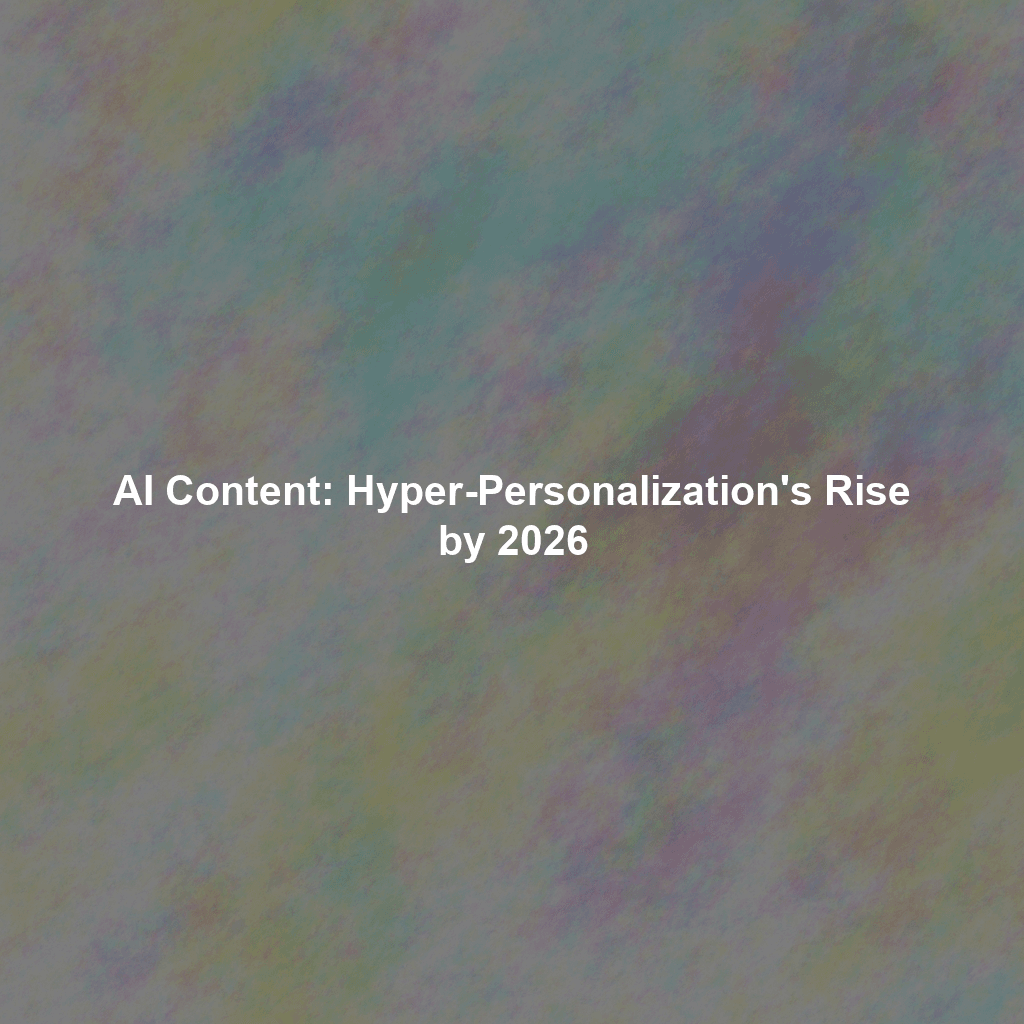The year is 2026. The marketing landscape is unrecognizable from even a few years prior. Artificial intelligence (AI) isn’t just a tool for generating basic content; it’s the conductor of a hyper-personalized symphony, orchestrated in real-time for each individual customer. This article explores how AI-powered content personalization will not only dominate marketing but fundamentally reshape customer experiences in the years to come.
The Evolution Beyond Content Generation: A Personalized Future
For years, the buzz around AI in marketing focused on content generation – writing blog posts, crafting social media updates, and even scripting video ads. While AI-generated content has its place, its impact plateaus without personalization. In 2026, the real power of AI lies in its ability to understand, predict, and respond to individual customer needs with unprecedented accuracy. We’re moving past simply creating more content to creating relevant content for each person.
The Rise of the Individualized Customer Journey
Imagine a customer browsing an e-commerce site. In the past, they would see a standard homepage with generic product recommendations. In 2026, AI analyzes their past purchases, browsing history, social media activity, and even real-time contextual data like location and weather. The homepage instantly transforms to showcase products they are most likely to buy, bundled with relevant accessories, and presented with messaging that resonates with their individual values and preferences. This is the individualized customer journey powered by AI.
A report by McKinsey & Company highlights that personalized experiences can deliver 5 to 15 percent revenue lift and 10 to 20 percent increase in customer satisfaction. ( McKinsey & Company: The value of getting personalization right—or wrong )
Predictive Analytics: Anticipating Customer Needs Before They Arise
One of the most significant advancements in AI-powered personalization is the use of predictive analytics. By analyzing vast datasets, AI can predict customer behavior with remarkable accuracy, allowing marketers to proactively deliver content that addresses their needs before they even realize they have them.
Unlocking the Power of Data
Predictive analytics relies on a wealth of data, including:
- Historical Purchase Data: Understanding past buying patterns to predict future purchases.
- Browsing Behavior: Tracking website activity to identify interests and preferences.
- Social Media Activity: Analyzing social media posts, likes, and shares to understand customer sentiment and brand affinity.
- Email Engagement: Monitoring open rates, click-through rates, and responses to email campaigns to refine messaging and targeting.
- Customer Service Interactions: Analyzing support tickets and chat logs to identify pain points and areas for improvement.
By combining these data sources, AI can create detailed customer profiles and predict future behavior with increasing accuracy. For instance, if a customer frequently purchases running shoes and has shown interest in fitness trackers on social media, the AI might predict that they are likely to buy a new fitness tracker in the near future. This allows marketers to proactively deliver targeted ads, email promotions, or even personalized content recommendations to encourage a purchase.
Real-World Example: Personalized Healthcare
Consider the healthcare industry. AI can analyze a patient’s medical history, lifestyle factors, and genetic information to predict their risk of developing certain diseases. Based on this prediction, the patient can receive personalized health recommendations, preventative care plans, and educational content tailored to their specific needs. This proactive approach can improve patient outcomes and reduce healthcare costs.
Real-Time Content Optimization: Adapting to User Behavior in the Moment
Personalization isn’t just about predicting future behavior; it’s also about adapting to user behavior in real-time. AI can monitor how users interact with content and instantly adjust the experience to optimize engagement and conversion rates. This dynamic personalization is crucial in the fast-paced digital world of 2026.
The Power of Contextual Awareness
Real-time content optimization relies on contextual awareness – understanding the user’s current situation and tailoring the experience accordingly. This includes factors like:
- Device Type: Optimizing content for mobile, desktop, or tablet devices.
- Location: Delivering location-based content and offers.
- Time of Day: Adjusting messaging and content based on the time of day.
- Referral Source: Tailoring the experience based on how the user arrived at the website.
For example, a user browsing a travel website on their mobile device in the evening might see different content than a user browsing the same website on their desktop computer during the day. The mobile user might be shown last-minute travel deals and nearby hotel recommendations, while the desktop user might be presented with more detailed information about vacation packages and travel guides.
A/B Testing on Steroids
Traditional A/B testing involves comparing two versions of content to see which performs better. AI-powered real-time optimization takes this concept to the next level by continuously testing and refining content based on user behavior. Instead of just testing two versions, AI can test hundreds or even thousands of variations simultaneously, identifying the optimal combination of elements for each individual user.
Companies like Optimizely are paving the way for this type of dynamic optimization, and by 2026, it will be commonplace. ( Optimizely )
Example: Dynamic Email Marketing
Imagine an email campaign promoting a new product. Instead of sending the same email to everyone, AI can dynamically adjust the content based on each recipient’s past purchases, browsing history, and stated preferences. Some recipients might see product images featuring their favorite colors, while others might see testimonials from customers with similar demographics. The subject line, call-to-action, and even the overall layout of the email can be personalized in real-time to maximize engagement and conversion rates.
The Ethical Considerations of AI-Powered Personalization
As AI-powered personalization becomes more sophisticated, it’s crucial to address the ethical considerations surrounding its use. Marketers must be mindful of data privacy, transparency, and the potential for bias in AI algorithms. Building trust with customers is paramount, and ethical practices are essential for long-term success.
Data Privacy and Security
Collecting and using customer data for personalization raises important privacy concerns. Marketers must be transparent about how they collect and use data, and they must obtain informed consent from customers. It’s also crucial to protect data from unauthorized access and breaches. Robust security measures and compliance with data privacy regulations like GDPR and CCPA are essential.
The General Data Protection Regulation (GDPR) in Europe and the California Consumer Privacy Act (CCPA) are examples of regulations that aim to give consumers more control over their personal data. ( GDPR ) ( CCPA )
Transparency and Explainability
Customers have a right to understand why they are seeing certain content and how their data is being used. Marketers should be transparent about the role of AI in personalization and explain how algorithms are making decisions. This helps build trust and prevent customers from feeling manipulated or deceived.
Ideally, AI systems should be “explainable,” meaning that their decision-making processes are transparent and understandable. This is particularly important in sensitive areas like healthcare and finance, where AI-powered recommendations can have significant consequences.
Bias and Fairness
AI algorithms can perpetuate and even amplify existing biases in data. If the data used to train an AI model is biased, the model will likely produce biased results. This can lead to unfair or discriminatory outcomes for certain groups of customers. Marketers must be aware of this risk and take steps to mitigate bias in AI algorithms. This includes carefully auditing data, using diverse training datasets, and regularly monitoring AI performance for signs of bias.
Challenges and Opportunities for Marketers in 2026
Adapting to the AI-driven personalization landscape presents both challenges and opportunities for marketers. To thrive in 2026, marketers must embrace new skills, adopt new technologies, and cultivate a data-driven mindset.
Challenges
- Data Silos: Breaking down data silos and integrating data from multiple sources is crucial for effective personalization.
- Talent Gap: Finding and retaining talent with the skills to manage and optimize AI-powered personalization systems can be challenging.
- Technology Complexity: Implementing and maintaining AI-powered personalization technologies can be complex and expensive.
- Maintaining Human Connection: Over-reliance on AI can lead to impersonal experiences. It’s crucial to maintain a human touch and ensure that personalization enhances, rather than replaces, human interaction.
Opportunities
- Improved Customer Engagement: Personalized experiences can significantly improve customer engagement, leading to higher loyalty and advocacy.
- Increased Conversion Rates: Targeted content and offers can drive higher conversion rates and revenue growth.
- Enhanced Customer Insights: AI can provide valuable insights into customer behavior and preferences, allowing marketers to refine their strategies and improve their overall effectiveness.
- Greater Efficiency: Automating personalization tasks can free up marketers to focus on more strategic initiatives.
To succeed in this evolving landscape, marketers need to invest in training and development, embrace new technologies, and foster a culture of experimentation and data-driven decision-making. Those who can successfully navigate these challenges and capitalize on the opportunities will be well-positioned to thrive in the AI-powered world of 2026.
The Future is Personalized: Are You Ready?
AI-powered content personalization is poised to revolutionize marketing in the years to come. By embracing predictive analytics, real-time optimization, and ethical practices, marketers can create hyper-personalized experiences that drive customer engagement, increase conversion rates, and build lasting relationships. While there are challenges to overcome, the opportunities are immense. The future of marketing is personalized – are you ready to embrace it?
As you navigate this evolving landscape, consider how partnering with experts in AI-driven solutions could accelerate your adaptation and ensure your marketing efforts are not just keeping pace but setting the standard for personalized customer experiences. This proactive approach positions you for sustained success in the hyper-personalized world of 2026 and beyond.
This article was optimized and published by Content Hurricane.
 Skip to content
Skip to content

